Bob Jane leading his champion driver, Spencer Martin onto the Hume Weir dummy grid for his first race in ‘Bob’s baby’, his Elfin 400 Repco 4.4 V8, June Queens Birthday weekend 1967…
Martin was by then the reigning national Gold Star Champion. In fact he was half way through a year in which he won his second title on the trot, and then having achieved his motor racing aims retired from the sport at elite level’.
#85 in the background is the ex-Bib Stillwell, Tony Osborne owned Cooper Monaco Olds V8 driven by Ian Cook.
Click here for an interesting article on Spencer; https://primotipo.com/?s=spencer+martin
The inspiration for this article are a number of great shots of the Hume Weir circuit near the mighty Murray River and border of New South Wales and Victoria. The circuit, closed in 1977 won’t be on the radar of international enthusiasts although Jack Brabham and Roy Salvadori raced there during the Australian International races in the summer of ’61.

Jack Brabham wins the ‘Craven A International’ in his Cooper T53 Climax in March 1961, love the ‘Fergy’ in the background, Hume Weir (unattributed)
I knew the circuit, i just missed racing there, it was closed by 1979 when in bought my first Formula Vee, was built in a disused quarry which provided construction stone and gravel material to build the Hume Dam, particularly its retaining wall. Although a Victorian i am a Thredbo skier, a legacy of 9 years working in Sydney and for years summer and winter have driven from Melbourne along the stretch of road from Ebden to Tallangatta with Lake Hume to my left. From Khancoban where the Alpine Way starts is a phenomenal drive to Thredbo Village. This drive, in fact the whole journey from Albury through Corryong, Khancoban, Geehi and Dead Horse Gap to Thredbo is one of Australia’s great drives.
Watch the ‘coppers’ though they police it furiously, the area near Scammells Lookout, a must stop, is an area to stick to the limits in particular!
For years i have driven for miles with Hume Dam on my left and wondered about the Hume Weir project and researched it, some old shots i found are too good not to share.
So, this masterpiece comprises a piece about the building of the Hume Dam, the birth of its Hume Weir Circuit ‘love-child’, the history and some shots of the circuit and a bit about Bob Jane’s Elfin 400 the photos of which at Hume Weir inspired the article.
For my international friends, the ‘where the hell is he talking about?’ question is addressed by the map below, ‘Hume Weir Circuit’ is in red, the road to Thredbo is also there.

1960’s aerial shot of Hume Weir circuit, dam and dam wall. At the bottom of the shot is ‘Scrub Corner’, the tightest hairpin in the country, then heading ‘up’ is the ‘Back Straight’ into the combination of corners called ‘The Loop’, then left (going down the page again) into ‘The Esses’ past the pit entry and onto the ‘Front Straight’, the start/finish line is at the start of which (Dallinger)
Australia is the driest continent on the planet, as a consequence there have been some major infrastructure projects since Federation in 1901 to provide water for irrigation of crops and/or power. The Hume Dam is one, on much bigger scales are the Ord River Scheme in WA and most impressively and significantly the post-war Snowy Mountains Scheme in NSW.
Travelling the roads mentioned above gives some insights into the ‘Snowy the scale of this nation building post-war project, its one of the civil engineering wonders of the world, can only be experienced on the ground, its un-Australian not to experience it at some point in your life!
Explorers Hume and Hovell trekked through the area in 1824, Albury was first settled by Europeans in the 1840’s.
As early as 1863, it was clear that water management was needed to ease the boom and bust flows of the rivers. Lochs and weirs were advocated but when representatives of the three colonies impacted, NSW, Victoria and South Australia met in Melbourne, the talks came to nothing. Not much different to today really, when the Premiers meet. Difficulties with border customs, bridge and punt tolls, along with self interest made necessary compromises between the parties impossible.
After Federation (when the colonies joined to form a country) in 1901 a more global view of national priorities was capable of being made and after consideration of 25 sites the present one was chosen.
The factual material which follows is a truncated version of a paper by Joe Wooding for the ‘Albury & District Historical Society’ on construction of Hume Dam.
To build a reservoir, lots of land is needed, in this case, prime river frontage. 15,582 acres in NSW and 87,268 in Victoria. Not everyone was pleased with the compensation offered, the lawyers were happy though as the courts were ‘chockers’ with disputes for over a decade.
In NSW the stone quarry is on Hawksview Hill. Four steam locos and numerous trucks were brought from Burrinjuck. The rail system was extensive, rails ran to and from the quarry and the Bethanga Bridge site. Rail was also used inside the coffer dam to service the spillway foundation excavations.
‘The process of using crushed rock rather than smooth river gravel and adding large rock individually, produces ‘cyclopean concrete’. A 750mm wide concave rubberized conveyor belt carried the concrete, which could be retrieved at any point, by concrete shutes, for placement at the work site. Belts were pressure cleaned for their return journey. The huge rocks, some weighing up to 10 tons, called ‘plums,’ were cleaned with a high pressure hose before being individually craned into the wet concrete. Some were completely buried, but many were left half exposed to ‘key in’ the next batch of concrete. Steel reinforcing was only used near the top of the spillway. The structure is about 17% rock. At its base, the wall is 32m thick and double that if you take in the dissipater wall’.
‘As well as road works in the villages, other amenities were provided. Residences, barracks, stores, recreation halls, a post office and police presence were established. Electricity was installed for lighting only and turned off at 11pm. A Church of England was transported in. A casualty ward, a doctor with a phone and car were provided. Dances and pictures, obviously silent, as ‘talkies’ were not seen in Albury until 1928. The school had 66 pupils in 1921. The baker, milkman, greengrocer and butcher called regularly as did the ice man. Sport attracted many of course’.
In 1957, the Power Station was completed with 2 turbines now capable of producing 58 Mw which is not large in the electricity industry. As a comparison, Albury’s peak demand for summe of 2013 was 110 Mw.
Hume Weir wasn’t the first circuit in the Albury area, Wirlinga was.
A public roads layout of 6.79K, roughly rectangular shape using Thurgoona, St Johns and Bowna Roads as well as the Riverina Highway was used. 14km from the centre of Albury, the track was used several times before WW2. Rather than get lost in that tangent now, tempting though it is, we will come back to Wirlinga another time.
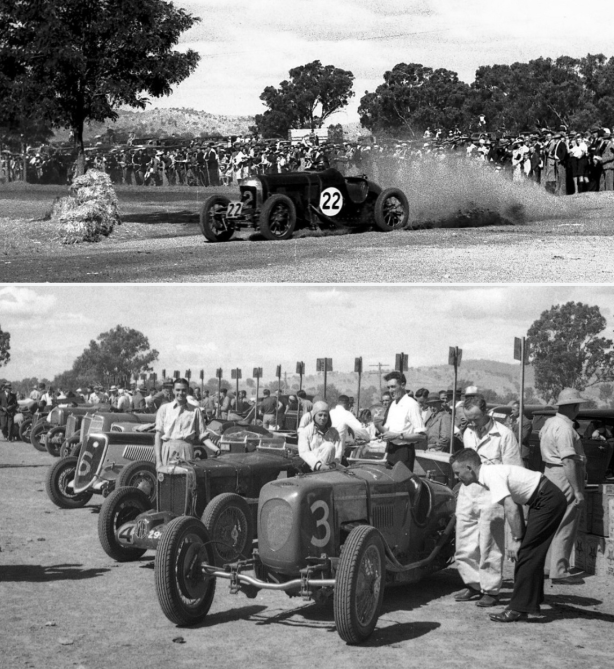
Car #22 is Alf Barrett’s Morris Bullnose Spl. #3 Tim Joshua’s Frazer Nash TT Replica, #4 Hope Bartlett’s MG Q Type, #6 Jack Phillips winning Ford V8 Spl, Wirlinga 1938 (Dallinger)
The 150 mile ‘Interstate Grand Prix’ (called the ‘Albury Grand Prix’ in the Sydney Morning Herald report of the 1939 race) was run on 19 March 1938. The ‘Albury and Interstate Gold Cup’ was run on 12 June 1939. Both handicap races were won by local Wangaratta boy, Jack Phillips Ford V8 Spl. The track wasn’t used post war.

The lower pic shows Les Murphy in the O’Dea MG P Type from Colin Dunne’s similar car and George Bonser’s Terraplane Spl, help wanted in relation to the cars in the upper shot Wirlinga 1938 (Dallinger)

Typically parched Australian summer, 1970’s. Hume Weir wall middle right and Great Dividing Range clear (unattributed)
Hume Weir Circuit…
Hume Weir was enormously popular in the immediate area, in fact depending upon the year the locals were served by Tarrawingee, Winton outside Benalla and the ‘Weir.
When the circuit was leased from the Hume Dam authority by the Albury and District Car Club the members initially established an unsurfaced layout which was first raced on 2 November 1959. It was lengthened to 1.1 miles during the year, first used sealed for the Christmas meeting on December 12 1959.
The financial support of Gold Star champion Len Lukey’s and his ‘Lukey Mufflers’ business allowed the amenities to be improved sufficiently to hold the 1961 international event. The ‘weir only got the gig, historian Stephen Dalton records as negotiations with PIARC to use Phillip Island fell over.
The 1961 program comprised an ambitious 21 events held on the Sunday and Monday 12 and 13 March, they were mainly short races with the feature ‘Craven A International’s 20 lappers on each day.
The meeting was contested by Brabham, Salvadori, Bib Stillwell, Bill Patterson, Austin Miller and Jon Leighton. It wasn’t a big field; Moss had long since left the country, as had the BRM drivers Hill, Gurney and Ron Flockhart and his Cooper.

This shot shows the two sections of the track separated by a narrow strip of concrete, March 1961 meeting perhaps (unattributed)
Brabham.
The Internationals that summer were raced at Warwick Farm, Ballarat Airfield in Victoria and Longford and won by Moss Lotus 18 Climax, Gurney BRM P48 and Roy Salvadori’s Cooper T51 Climax respectively.
The Longford meeting was on March 5, Brabham and Salvadori travelled back to Melbourne from Tasmania, the Coopers were towed up the Hume Highway, the main Melbourne/Sydney artery to contest the ‘Craven A Internatioanals’ at Hume Weir on 12 and 13 March. No doubt it gave Jack an opportunity to catch up with his family in Sydney.
It was all fairly casual, Jack’s car was accompanied by his mechanic and a driver for the towcar, an FC Holden Station Wagon which was maintained at a local Esso servo/workshop.
Jack won the race on the Sunday by just 0.9 sec from Patterson, the reigning Gold Star champion and Bib Stillwell’s Cooper T51’s in his T53.’The last 3 laps saw the leaders in the esses together and the crowd was wild with excitement as it was still anybody’s race but Jack Brabham showed championship form and held off the challenge to win’ said the Border Mails report.

Austin Miller’s distinctive yellow Cooper T51 Climax perhaps chasing Jon Leighton’s Cooper T45 and Roy Salvadori’s T51 during the Sunday race in which they were 4/5/6th (unattributed)

Roy Salvadori sussing the size of the cheque- ‘Can you make it in pounds sterling matey?’ (C McQuellin)
On Monday ‘Brabham streeted the field in the international cup race and set a lap record of 51.2 seconds, a time equated to 147kmh’. ‘Twas again a Cooper 1-3, JB winning from Stillwell and Jon Leighton in Cooper T51 and T45 respectively.
With that both internationals jumped on a plane for the UK, their first event the Lombank Trophy at Snetterton which Jack won in his Cooper T53, Roy was 5th in a similar car.
The short nature of the circuit perhaps mitigated against its use for championship events having said that it hosted a round of the Australian F2 Championship from 1973-76…
Later multiple Gold Star winner Alfredo Costanzo set the all-time lap record in a Birrana 274 Hart 1.6 F2 car on 15 June 1975, in 1976 the circuit also held a round of the Australian Sports Car Championship, fundamentally though it is a circuit which is fondly remembered by club racers of both bikes and cars and spectators of course.
The circuit was essentially ‘killed-off’ by CAMS with ever increasing and more difficult safety requirements which the owner/promoters couldn’t afford. There was a section where the cars passed each other separated by a concrete wall which was of particular concern.
The last race meeting was held on 27 March 1977 although the track was used as part of the Alpine Rally which was run out of Bright, not too far away. Every now and again a ‘comp sec’ of a car club convinced CAMS to issue a permit for a ‘sprint event’ but essentially another circuit was lost, a real shame as the usual causes; noise in a built up area or urban encroachment which simply made the entreaties of property developers irresistible to circuit owners didn’t apply in this rural area.
The photo above nicely juxtaposes the Dam with the circuit which is clear to see above the dam wall in the middle of the picture, plenty of water about in this shot! At present it is as dry as!
Molina Monza Holden Spl.
You get a sense of just what a magnificent natural ampitheatre the circuit was, most of but not all of the circuit could be seen from one place. This is the Molina Monza Holden Spl, the shot isn’t dated so not sure who the driver is. The car’s specifications are outlined in this article amongst other Oz cars; https://primotipo.com/2015/05/13/shifting-gear-design-innovation-and-the-australian-car-exhibition-national-gallery-of-victoria-by-stephen-dalton-mark-bisset/
Perkins.
Larry Perkins in the ‘boonies’ at ‘Scrub Corner’ on 28 December 1969 early in his career, car is characteristically a Perkins Vee. He is looking for a marshall to help him back to terra firma.
He was in F1 in a private Ensign nee Boro in 1975. This is early days tho, his early break was to get one of Bib Stillwell’s Elfin 600FF seats in 1971 taking the ‘Driver to Europe’ series. He stayed in Oz for ’72 and raced an Elfin 600B/E Ford to win the national F2 title. He then took Garrie Cooper’s first Elfin 620FF to the Formula Ford Festival at Snetterton at the end of the year, contesting the Festival with a few other Aussies and then stayed in the UK. F3 in 1973 and the rest is history…
Brock.
Peter Brock ahead of Lynn Brown’s Cooper S, these are ‘Sports Sedans’, anything goes sedans with Brock and Brown two of the sports finest pracitioners of the art. Brocky is young and made his Holden ‘Red’ 6 cylinder engined A30 sing, his performances in it resulted in Harry Firth, fine judge of talent picking him up as a Holden Dealer Team driver. Brock took his first Bathurst win in 1972.
‘Peter Perfect’ only did one fullish season in single-seaters in this ex-works Birrana 272 Ford, its the very first of Tony Alcock’s monocoque cars. A good car but it didn’t have a Hart Ford engine, and the competition was hot in 1973-5 in F2, Brocky quickly went back to Holdens. A great pity, a natural driver of great smoothness, finesse and throttle control; oh to have seen Brock in a Repco Holden engined F5000 in the 1970’s!
Hansford.
Greg Hansford blasts onto the main straight 1977. Kawasaki KR750 water-cooled 2 stroke.
Beechey.
Beechey changed from Holden to Ford running this ex-works Series Production Ford Falcon GTHO Ph3 with some cash from Ford in 1972. Here he is in April, DNF with clutch failure. Ford apparently then changed their minds wanting Norm to return the car and money they paid him, Norm telling them unsurprisingly to ‘jam it’.
Bartlett.
Kevin Bartlett in polo-shirt at the wheel of the works Lynx BMC, the Curl-Curl kid was on his way! Lotus 20 behind i think. Year anyone?
Bikes.
Jim Budd and Roger Hayes Team Avon Kawasaki’s lead the 1 hour production race at the ‘weir in November 1977. Third is Jeff Parkin and then Alan Hales both on Suzuki’s. Hot work in the heat.
Jane.
Bob giving his factory Shelby built Mustang Trans-Am plenty during the 1970 Christmas ‘Weir meeting. His new Chevy Camaro 427 cannot be too far away, Norm Beechey took the 1970 ATCC in his Holden Monaro GTS350 but Jano won it in 1971/2 in the same car with a 427 in ’71 and ‘tiddly’ 350 small block in 1972.
Bob was back with another new toy in 1971, one of his finest, the John Sheppard built Holden Torana into which was slotted one of the 4.4 litre SOHC ‘620 Series’ Repco V8’s once fitted to the Elfin 400 pictured below. CAMS didn’t allow it to compete with the wing for long, check out the Vees in the Weir ‘form up’ or dummy grid area in the background. This car was mainly raced by John Harvey, in ’71 Bob focused on the Camaro and winning the ATCC. The car is still around albeit Chev engined and in need of restoration.
Bob Jane didn’t race his Elfin 400 too much, it was mainly driven by his drivers; Spencer Martin, Ian Cook and Bevan Gibson.
Here in early 1968 at Hume Weir Jane is ahead of a Lotus 11, Meyers Manx beach buggy! and, is it an Elva Courier. These big Elfins are sensational cars, i wrote a long article about them a while back, click here to read it;
Elfin 400/Traco Olds: Frank Matich, Niel Allen and Garrie Cooper…
It’s interesting to see racing cars in the context of their day to gauge the impact they had on people, how ‘other worldly’ and fast they looked. Seeing them at historic race meetings is not the way the populace saw them at the time.
This shot does that in spades and the fair citizens of Conmurra Avenue, Edwardstown, an Adelaide suburb had seen plenty of cars leave the Elfin factory in their street. This one clearly captured their attention all the same.
That WOW! factor we all still experience at the sight of something really special, mind you, these days it’s usually the ‘WOW! Ugly as a Hatful of Arseholes’ impact rather than ‘WOW! Beautiful’. Such is the impact of cad-cam and the aerodynamicists ‘art’ on free flowing curvaceous forms.
The Mini 850 and Holden ‘EH’ on the typically Aussie outer suburban street nicely juxtapose the body of Elfins first ‘big-banger’ sports car with contemporary ‘roadies’ of the day.
WOW! indeed.
Elfin built four Elfin 400’s, all with different engines, the first completed was the Frank Matich Elfin 400/ Traco Olds featured in the article link above.
This car is about to be delivered to Bob Jane Racing in Melbourne in early 1967 in time for the sports car events which were a part of each years Tasman rounds.
It’s the first 4.4litre Repco ‘620 Series’ V8 fitted to a car, the engine developed in parallel with the 1966 Championship winning 3 litre variant of the same engine, victorious in Jack Brabhams hands that year.
In fact it is the first customer Repco engine sold, the first fitted to a sports car and the first fitted to a car built in Australia, Brabhams were built in the UK. So, significant in Repco’s’ history.
The SOHC 2 valve, Olds block, Lucas injected engine produced around 400bhp@8000rpm, enough in Australia, but not elsewhere in the world at the time, where big Chevs were dominant. In 1965/66 the Lola T70 was the ‘ducks guts’ in Group 7 sports car racing but the McLaren M6A appeared in 1967, from that moment the record books were attacked by the McLaren steamroller until the end of 1971 when Porsche ‘rained on their parade’ with the 917/10 and 917/30 turbo’ cars.
As stated above this car was raced by Jane himself, Ian Cook and Bevan Gibson. Unfortunately it was the car in which Bevan flipped on Conrod Straight, Bathurst at the Easter 1969 meeting, killing the promising young driver instantly.
Frank Matich was dominant in his range of sports cars in Australia into 1967, pickings at championship level were slim when FM was present. Matich’s Elfin 400 Traco Olds delivered its promise and his own SR3’s were almost identical in terms of chassis to the Elfin 400 if not the body.
The ex-Jane 400 is now restored and owned by Elfins’ Bill Hemming.
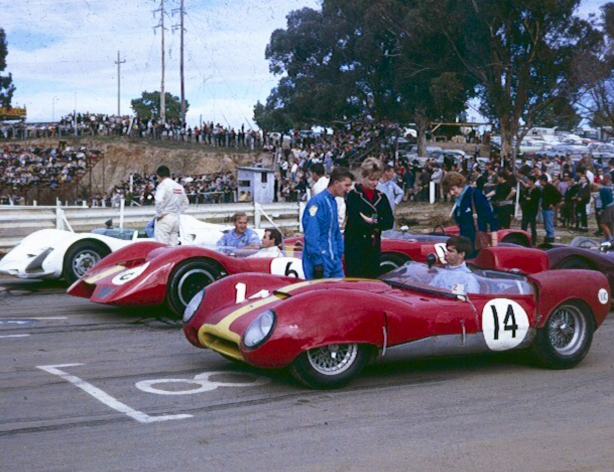
Hamilton Porsche 906 Spyder, Spencer Martin Elfin 400 Repco and Bevan Gibson Lotus 15 Climax, Hume Weir, Queens Birthday weekend 1967. Somewhat poignant shot given Bevan is to die in the car beside him 2 years later. Gibson made the families Lotus 15 Climax absolutely sing, it was his drives in this old car which earned him the Bob Jane drive (Bryan Liersch)
Bibliography…
Joe Wooding ‘Albury & District Historical Society’ paper on construction of Hume Weir
‘Elfin Sports and Racing Cars’ John Blanden and Barry Catford, Elfin Sports Cars Facebook page
Photo Credits…
Bryan Liersch, Bob Mills Collection, Dick Simpson, John Small, oldracephotos.com, Bowdens, Bruce Wells Collection, Robert Davies, Bowdens, Christopher McQuellin, Phil Hall, Terry Kelly Collection, Pat Hawthorn Collection
John J Dallinger’s stunning collection of Albury photographs
Tailpieces: Family, fun day out at the Weir…
Finito…




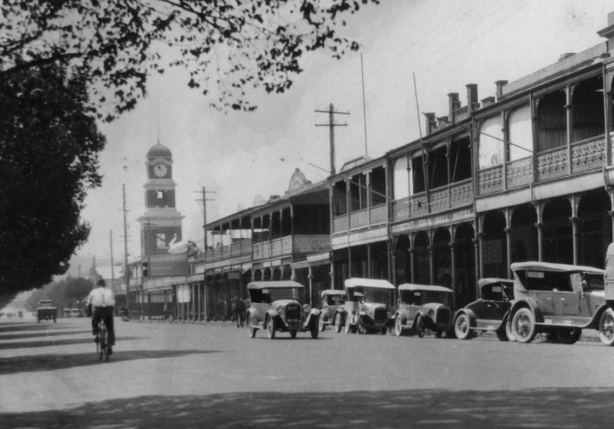

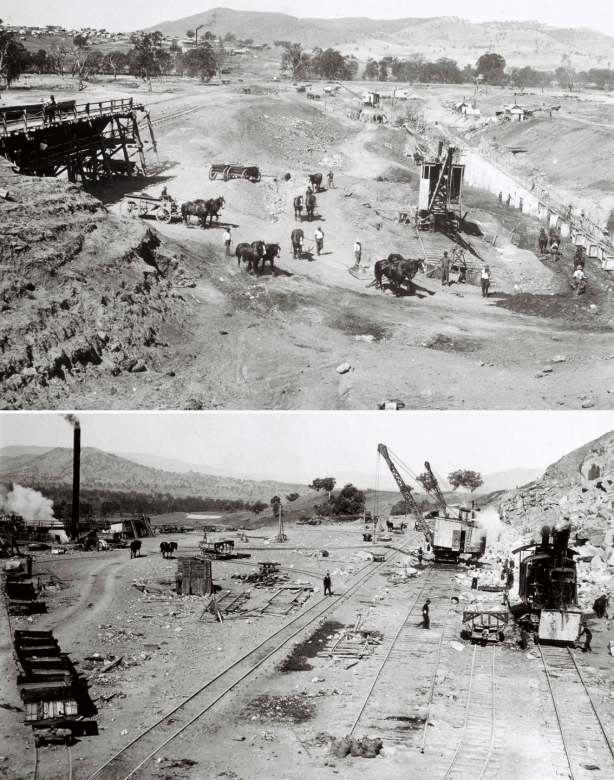


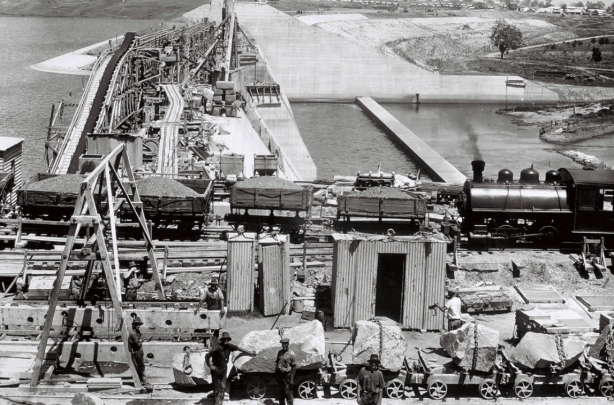



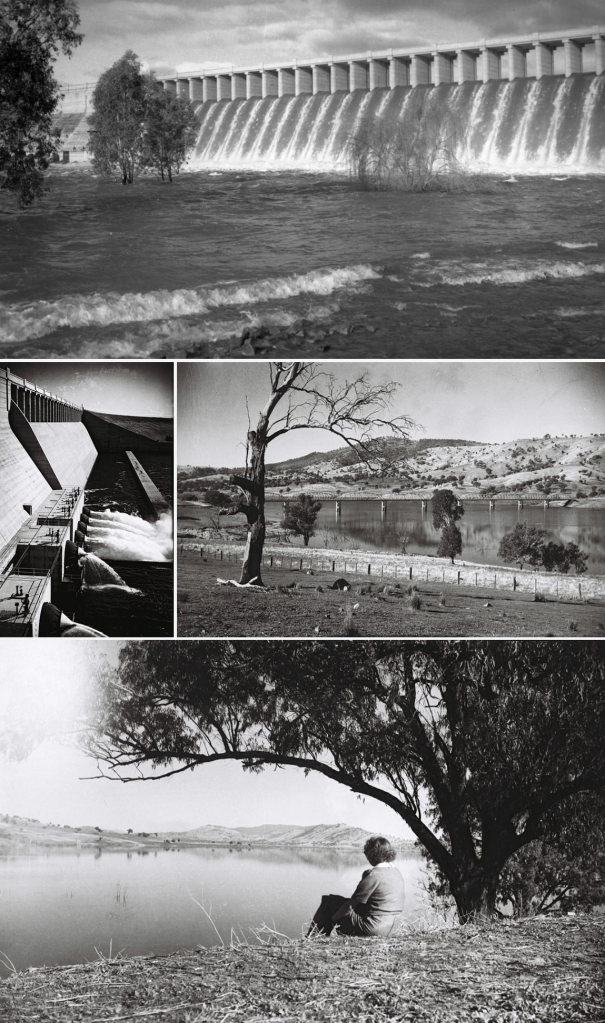
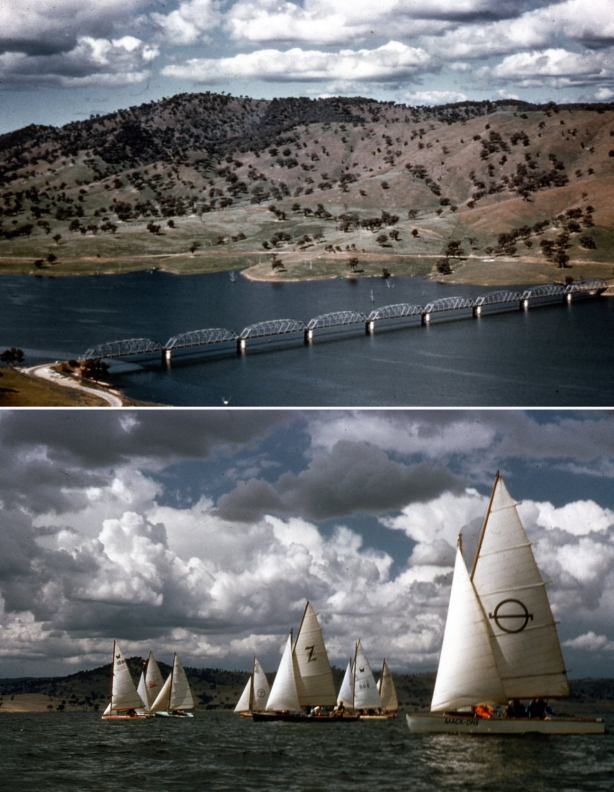

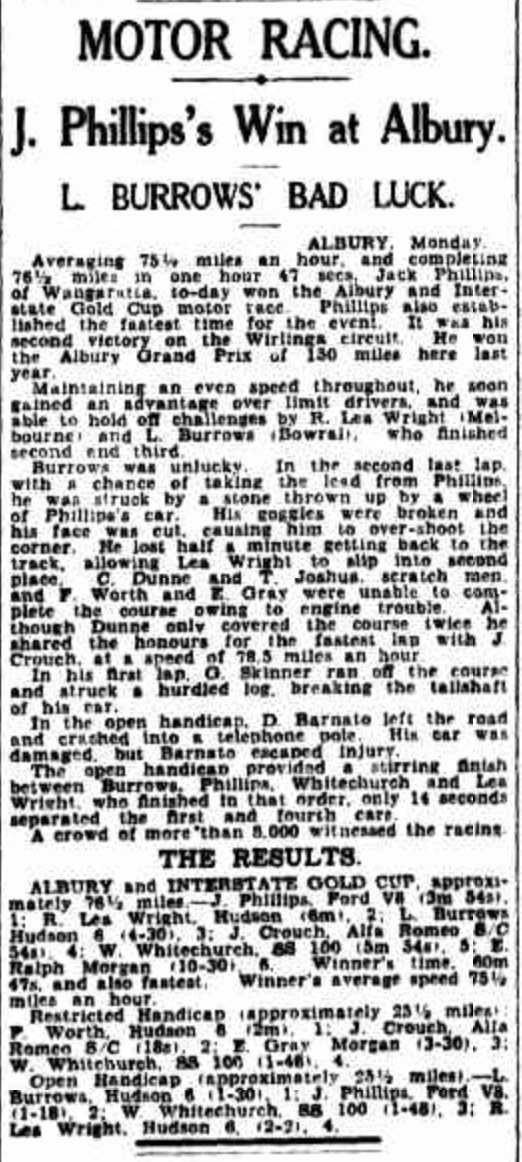
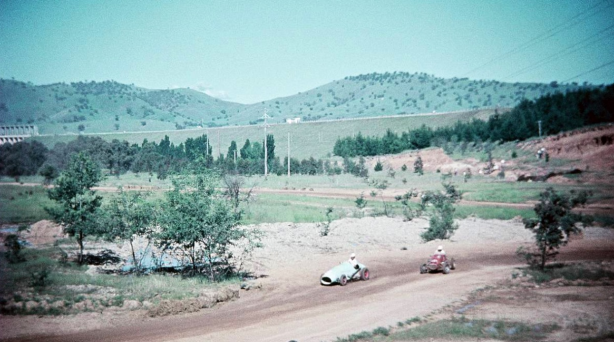
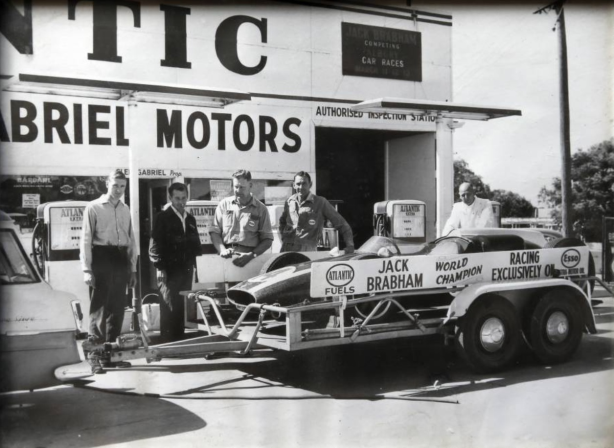










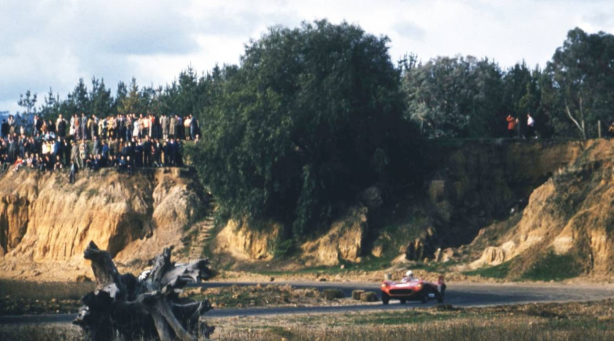




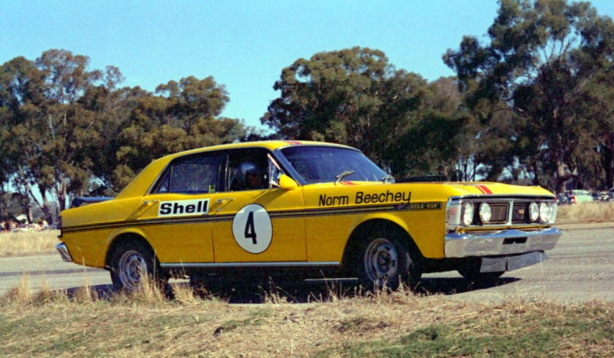
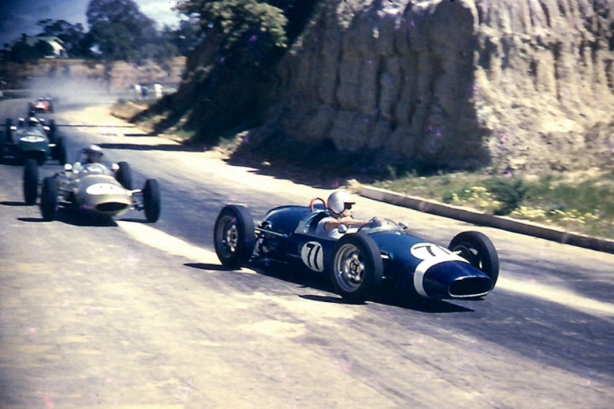




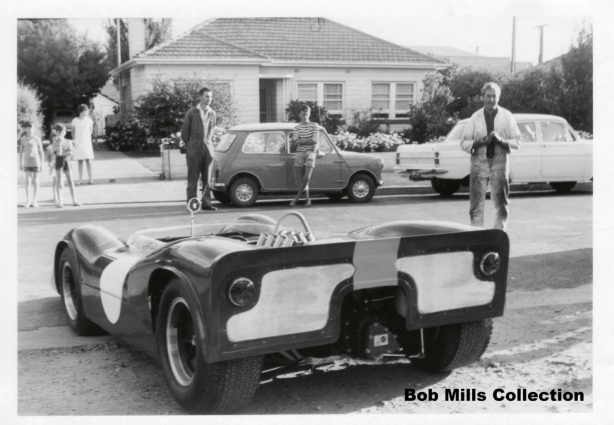

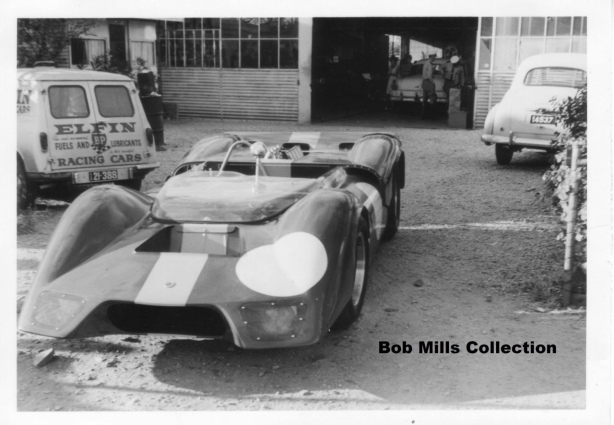




6 photo’s back I was one of the citizens in Conmurra Ave, Edwardstown S.A. standing in the driveway opposite Elfin’s at the age of 8. We lived opposite (for 30 plus years) and saw many of the cars made even sometimes helped push them down the street to start them for testing……the noise! particularly the F5000. My older brother Mark got involved in helping Garrie Cooper track side due to his interest in racing cars. 4 photos back I remember Garrie Coopers dad, Cliff driving his Mini panel van for many years. I was told Cliff had an Elfin racing car inside his house at Kangarilla (Adelaide Hills – SA) which sounded like a great story.
Garrie Cooper was a great motor sport pioneer in Australia particularly given his distance from the rest of the worlds motor sport giants.
Thanks so much John for getting in touch, sorry to be so slow in responding.
You are a lucky chap to have lived there, my only trip to Conmurra Ave was to see the progress of the build of my Crusader Vee, I remember it very well.
Garrie was such an understated bloke, I think the scale of his achievement on so many levels has only really been recognised since his passing.
To take on, and beat the world says it all. In a commercial sense he had a profitable, family business for 25 years in the most fickle of worlds, no-one else in Oz has done that building racing cars. A great shame was his passing way, way too early. It would have been fascinating to just how he would have evolved the business to meet the challenges of the eighties and nineties.
Mark
[…] https://primotipo.com/2016/05/06/hume-weir/ […]
[…] https://primotipo.com/2016/05/06/hume-weir/ […]
[…] Who can tell us a bit about this special? Hume Weir, down the decades is here; https://primotipo.com/2016/05/06/hume-weir/ […]
[…] Club sprints and the like were held long after the final open meeting, see here; https://primotipo.com/2016/05/06/hume-weir/ […]